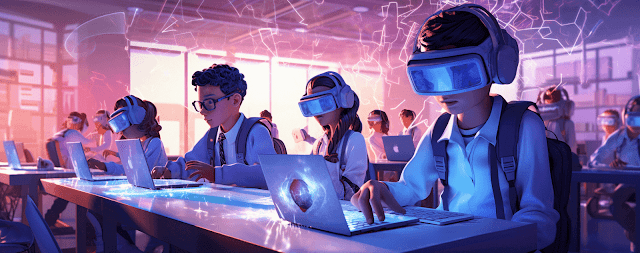Virtual Reality in Education and the Metaverse: Shaping the Future of Learning and Work
In recent years, we have witnessed an extraordinary transformation in how we learn and work, thanks to two groundbreaking technologies: virtual reality (VR) and the metaverse. While these innovations are often discussed separately, they are closely intertwined, revolutionizing education and the workplace in tandem. This article explores the intersection of virtual reality in education and the metaverse, highlighting the opportunities and challenges that lie ahead.
Virtual Reality in Education: Bridging Gaps and Enhancing Learning:
Virtual reality has found its stride in education, offering immersive experiences that traditional methods cannot replicate. In classrooms around the world, students are donning VR headsets to explore ancient civilizations, dissect virtual frogs, and even conduct complex physics experiments—all from the safety of their desks. This technology has the potential to bridge educational gaps, providing equal access to high-quality learning experiences regardless of location or socioeconomic background.
One significant advantage of VR in education is its ability to engage students on a deep level. Interactive VR simulations and virtual field trips can ignite a passion for learning, making complex subjects more accessible and enjoyable. Moreover, educators are finding that students retain information better when they can interact with it in a 3D virtual environment.
The Metaverse and the Future of Work: Virtual Offices and Remote Collaboration:
Simultaneously, the metaverse is reshaping the future of work. With an ever-growing number of companies adopting virtual offices and meeting spaces, professionals are discovering the benefits of remote collaboration. In a metaverse-driven workspace, geographic boundaries become irrelevant, enabling teams to work together seamlessly from different corners of the world.
Virtual reality is at the forefront of this transformation. Employees can now attend meetings, conferences, and even trade shows without leaving their homes. This not only reduces the carbon footprint associated with business travel but also promotes work-life balance. The metaverse is fostering an environment where employees can be productive while enjoying the flexibility of remote work.
The Synergy of VR and the Metaverse: A Dynamic Learning and Working Environment:
What makes this convergence of VR in education and the metaverse particularly exciting is their symbiotic relationship. As VR technology continues to improve, it will offer more realistic and immersive educational experiences within the metaverse. Imagine students exploring historical sites with classmates from different continents, all in a shared virtual space.
Similarly, the metaverse will benefit from educational content. As more educational institutions and businesses create and share content within the metaverse, it will become a richer and more versatile space for learning and work. Students may soon find themselves attending lectures, conducting group projects, and collaborating on research in metaverse-based environments.
Challenges and Considerations:
However, this transformative journey is not without its challenges. Privacy and security concerns are paramount, especially when both education and work are conducted in virtual environments. Ensuring that personal data is protected and that online harassment is minimized is essential.
Moreover, equitable access to VR technology and the metaverse must be addressed to prevent creating a digital divide. Schools, companies, and governments must work together to make these technologies accessible to all.
Conclusion
The fusion of virtual reality in education and the metaverse is ushering in a new era of learning and work. It offers the potential to make education more engaging and accessible while revolutionizing the workplace through remote collaboration and virtual offices. However, as we navigate this exciting terrain, it is crucial to address challenges related to privacy, security, and accessibility to ensure that the benefits of these technologies are realized by all. The future of learning and work is here, and it's taking us to places we could only dream of before.



Comments
Post a Comment